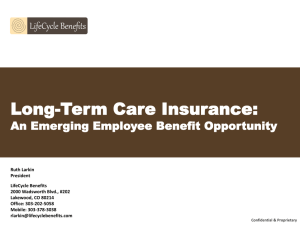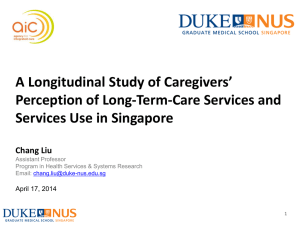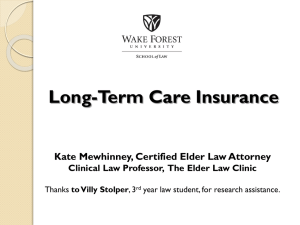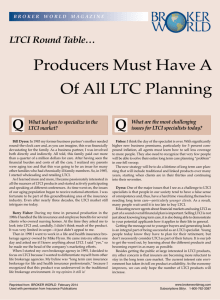Land this Plane - Long Term Care Discussion Group
advertisement
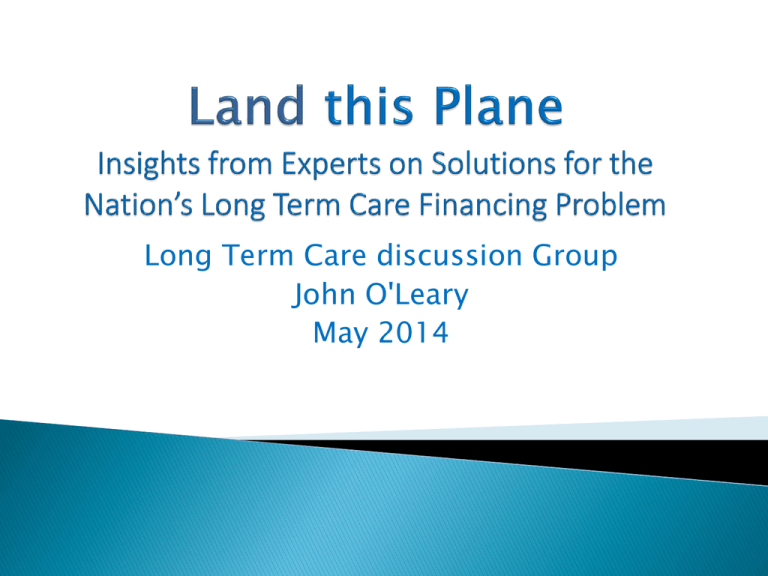
Long Term Care discussion Group John O'Leary May 2014 Think Tank Co-Chairs ◦ Roger Loomis ◦ Ron Hagelman Project oversight group (POG) ◦ ◦ ◦ ◦ ◦ ◦ ◦ Steve Schoonveld John Cutler Ben Wolzenski Jason Bushey Clark Ramsey Julie Flaa Brian Grossmiller ©OLeary Marketing Associates 2013 Background and context System overhaul Government role Social insurance High deductible/catastrophic coverage/short term care/Medicare LTC Re-insurance Medicaid reform Regulatory reform Next steps and implications Questions ©OLeary Marketing Associates 2013 Expectation: LTCi would play a prominent role in financing LTSS Traditional LTCi products turned out more expensive for consumers and more risky for carriers than expected Some carriers exited the market for many different reasons and a market consolidation ensued Traditional LTC insurance, short-term care and hybrid products continue to attract a variety of consumers Middle income solutions are evolving Overall market penetration below 10%, not including Hybrids How should the US deal with the long-term care financing situation facing us? Beginning in Jan 2013, a study of long-term care experts was undertaken by The Long-Term Care Think Tank The study was sponsored by two SOA committees: ◦ Long Term Care Section and ◦ Forecasting & Futurism Section The panel was comprised of more than 50 LTC experts chosen by the Think Tank POG Group included mix of well known and respected actuaries, public policy experts, regulators, other insurance industry experts Delphi allows participants to anonymously take positions, explain them, listen, and react to opposing viewpoints Then, ideally move toward consensus opinions Represents the collective opinion of expert panelists-not statistically significant Combines quantitative and robust qualitative responses- not just the what, but also the why To be clear-This presentation does not represent the opinions of The Society of Actuaries but rather the results of research conducted by the LongTerm Care Think Tank with SOA support. Three rounds: Increasingly detailed questions that built on the responses from prior rounds: Round 1- 30 questions; completed in March 2013 Round 2- 6 Principles; completed in June 2013 Round 3- Included review of several product concepts; completed in September 2013 Study output: Approximately 250 pages of quantitative responses and qualitative comments Here is where to find the full report: http://www.soa.org/Research/ResearchProjects/Ltc/research-2014-ltp-ltc.aspx A systemic overhaul of the Long-term care financing system is needed (86% agreed) Private Insurance needs to be part of the financing solution (100% agreed) A revised long-term care financing system should: ◦ Incent responsible long-term care planning (100% agreed) ◦ Incent healthy lifestyles (79% agreed) ◦ incent household and family participation (86% agreed) Tracking Panelists' Evaluations by Round Systemic overhaul Private insurance needed System should incent: Planning Healthy lifestyles HH & family involvement Agree 82% 100% Round 2 Disagree Ratio A/D 13% 6.3 0% Agree 86% 100% Round 3 Disagree Ratio A/D 5% 17.2 0% 100% 74% 84% 0% 12% 4% 100% 79% 86% 0% 9% 5% 6.2 21.0 8.7 17.2 The government needs to take an active role in defining the overall Long-term care financing solution (91% agreed) It should include ◦ A government sponsored LTC awareness and education campaign (90% agreed) ◦ A more flexible LTC Partnership program (83% agreed) ◦ Tax credits for the purchase of LTC insurance (82% agreed) Tracking Panelists’ Evaluations by Round: Active Government Role Round 2 Active government role LTC awareness campaign More flexible Partnership Tax credits for LTCI Impose filial responsibility Agree 89% 77% 76% 85% 18% Disagree 10% 23% 24% 15% 82% Round 3 Ratio A/D 8.9 3.4 3.2 5.7 0.2 Agree 91% 90% 83% 82% 15% Disagree 7% 10% 17% 18% 85% Ratio A/D 13.0 9.0 4.9 4.6 0.2 Panelist’s comment The playing field is a mess and CANNOT be solved by private-only actions. The free market needs to have some guidelines that only federal presence can define. The government's role should be more (to) organize a workable LTC system with ample choice of settings, services, and adequate financing. It should incentivize higher- and middle-income people to save for LTC and, if they don't tax them in a progressive way, to finance basic needs. The government also needs to make sure programs are well run. Panelists words and phrases ◦ ◦ ◦ ◦ ◦ ◦ ◦ ◦ ◦ Organize Incent Monitor Educate Influence Define Structure (Medicaid) Comprehensive set of solutions Not another unfunded liability ©OLeary Marketing Associates 2013 Social Insurance is a necessary component of a future LTCi system (84% agreed) Need for a limited SI program for people who can’t buy LTCi due to cost or U/W (73% agreed) Could accept SI even if they didn’t agree with the specific principle (90% agreed) Necessary characteristics of SI include: ◦ Catastrophic coverage (81% agreed) ◦ Mandatory participation (78% agreed) Tracking Panelists’ Evaluations by Round: Social Insurance Round 2 Social insurance required Social insurance principle Could accept SI principle Round 3 Agree Disagree Ratio A/D Agree Disagree Ratio A/D 81% 18% 4.5 84% 11% 7.6 62% 26% 2.4 73% 14% 5.2 90% 10% 9.0 Necessary Characteristics of a Social Insurance Program YES NO Catastrophic coverage 81% 19% Mandatory participation 78% 22% First-dollar coverage 11% 89% HCBS coverage only 15% 85% Institutional coverage only 9% 91% Panelist comment A Social LTCI program MUST be catastrophic only.… If we want a public-private solution in which some LTC coverage comes from the government and some comes from insurers, we need to create a situation in which the insurance component can be sold. That can occur ONLY with a catastrophic-only government program…. Definition in study was official actuarial definition Highlights included: ◦ Benefits and financing method prescribed by law ◦ Explicit accountability (e.g. trust fund) ◦ Funded by contributions and investment income which in some programs are government income from other sources ◦ Universally or almost universally compulsory, for a defined population, or contribution is at such a subsidized level that vast majority of the population are eligible to participate Social insurance product concepts LTC Savings program (68% agreed was viable) High deductible plan (67% agreed was viable) Short-term care (60% agreed was viable) Universal LTC (63% agreed was viable) Mutual LTC (53% agreed was viable) Medicare LTC (52% agreed was viable-43% disagreed) Social Insurance Product Concepts: Viability Ratings Agree Disagree Ratio A/D Consumer Viability Carrier Viability Govt. Viability Positive Impact LTC Savings Program 66% 68% 25% 2.7 81% 87% High-deductible plan 77% 67% 26% 2.6 74% 86% 60% 35% 1.7 79% 80% 52% 43% 1.2 75% 75% 63% 28% 2.3 56% 90% 53% 28% 1.9 53% 80% Short-term care 65% Medicare LTC 39% Universal LTC 52% 44% Mutual LTC 40% Baseline coverage for catastrophic LTC Consumers responsible for first 1, 2, 3 years-their choice Healthy living credits to reduce deductible Mandatory offer Private underwriting but federally sponsored (FLTCIP) Preferred vs. Short-term care Issue-Many may not be able to fund deductible Panelist’s comments The insurance premiums for a three-year elimination period would be much more affordable than for today's typical 90-day elimination period. Up-front private/back-end public seems like a good partnership—win/win. Considerable support in prior rounds for LTC Savings plan 78% and 89% respectively Tax favored treatment/unused could be passed on Mandatory Issues ◦ Can’t save enough for catastrophic problem ◦ Mandatory not viable politically ◦ Current low retirement savings Interest in combining with supplemental insurance Panelist comment Limited, modest benefit encourage use of informal care and care management Supplemental help during first 1-2 years Mandatory offer More affordable premiums Underwritten by private insurance; federally sponsored i.e. FLTCIP Panelist’s comments Like this because it provides a "something is better than nothing" answer and it helps consumers when they most need it, at the beginning of an episode. As long as it is marketed correctly, and does not over-promise protection; should not mislead. This would only work with a catastrophic backstop provided by government Federal govt. establish mandatory program with standardized catastrophic LTC benefit for all Standardized supplemental benefits would dovetail with basic benefit and fill gaps and pay deductibles i.e. inflation protection, informal care, deductibles and co-pays Like Medicare available at age 65 43% disagreed viable (highest in study) Only 39% thought was viable for govt.- step too far Panelist’s comments The general idea of mandating LTC makes sense to me. The idea of allowing supplemental coverages to provide beefier, more costly benefits also appeals. I don't know that there's enough money in the federal coffers to pay for it. Other significant concepts • Tax Deferred savings- 77% agreed was viable • Funds in tax deferred accts. (401K, 403B, IRAs) can be moved to qualified LTC protection on a tax and penalty free basis • potential to offset forgone tax revenues with Medicaid savings • National re-insurance Plan- 61% agreed was viable • Federally sponsored LTC re-insurance corporation • Would provide re-insurance for catastrophic claims that exceed certain pre-defined levels • Would limit required capital requirements • Provide a backstop that would assure consumers Tax-deferred savings National reinsurance Agree Disagree 77% 11% 61% 27% Ratio A/D 7.0 2.3 Consumer Viability 88% 81% Carrier Viability 95% 79% Positive Impact 75% 62% Panelist’s comments-re-insurance I don't know if the reinsurance structure can be made financially viable, especially given the reactions of virtually ALL of the reinsurers that exited the market for LTC. I would rather see creative ideas used to entice more private competition, which would be preferred to another government entity. Don't put the government in a risk management position on a reinsurance pool. Perhaps allow credit guarantees for reinsurers. Federally sponsored corporation to provide reinsurance for catastrophic claims Spread risk beyond individual carriers Limit needed capital requirements Encourage lower risk charges, hence more affordable premiums; Provide consumer assurances Issues: Federal stepping into private role ◦ Fanny Mae/Freddy Mac reaction? ◦ Not another federal organization Principle: Medicaid needs to be changed to tighten eligibility by closing loopholes, strengthening eligibility requirements, and enforcing the rules strictly. At the same time, it also needs to be modernized to enable care on a national basis in the full range of settings. This includes home- and community-based care if appropriate and cost-effective Medicaid Tightening described above (80% agreed) Medicaid Modernization as described above (86% Agreed) Among strongest responses in study Panelist’s comments I think tightening the abuses is extremely important. It distresses me to see attorneys who make their living helping people find loopholes to get Medicaid when they really are not eligible. At the same time, revising the way the eligibility works would make a lot of sense. While progress has been made, much more can be done to address a continuing Medicaid institutional bias. NAIC Model Act and LTC regulations need substantial revision (79% agreed) ◦ Balance affordability and meaningful benefits for consumers with predictable risks for carriers ◦ Modify regulations to allow more consumer cost sharing (examples included) Eliminate minimum periodic benefits (60% agreed) Allow benefit periods less than 1 year (59% agreed) Make adult day care a home care option (74% agreed) Make personal care services a homecare option (60% agreed/40% disagreed) Modify Regulations: Round 2 Results Modify NAIC Model Act Competitive decline obstacle Benefit periods < 1 year Eliminate periodic benefits Unbundle home care Adult day optional Care by home aides optional Agree Disagree A/D Ratio 79% 12% 6.6 19% 4.0 59% 34% 1.7 60% 19% 3.2 52% 29% 1.8 74% 26% 2.8 60% 40% 1.5 76% Modify Regulations: Round 3 Results LTC Marketing and Sales need to be improved by mainstreaming the message (67% agreed) ◦ Advisors have a fiduciary responsibility to discuss LTC risks and costs with their clients (88% agreed) ◦ NAIC partnership training should be integral to CE credits (86% agreed) ◦ LTC knowledge should be a core requirement professional designations (79%) Improve Marketing and Sales: Round 3 Results Agree Disagree A/D Ratio 86% 10% 8.6 79% 2% 39.5 43% 40% 1.1 29% 1.7 NAIC/PART training should be integral to CE credits LTCI knowledge should be core requirement of prof. designations L&H companies encouraged to offer CI options For training, CI accelerated death considered LTCI 50% Improve Marketing and Sales: Round 2 Results Agree mainstream message 67% 16% 4.2 Partnership certify agents to sell LTCI 39% 28% 1.4 L&H companies have obligation to sell LTC 26% 50% 0.5 Prof. designations should mandate LTCI training 39% 34% 1.2 24% 1.8 05% 17.6 NAIC should require training for CI riders 42% Improve Marketing and Sales: Round 1 Results Advisors have fiduciary to talk about LTC risks & costs 88% No single silver bullet Total system re-definition required Private insurance needs to be part of the solution Medicaid reform needed as part of the solution Social insurance needs to be part of the solution Catastrophic and savings concepts resonated Government needs to play an active role in system definition, guidance, incentives and education National awareness and education program needed Legislation and regulation needs to be revised Consumers need to be encouraged to plan and incented to take responsibility for their care; National LTC plan- joint committee of government, industry other stakeholders- Bi-partisan Policy commission a good start Economic analyses ◦ Tax deferred savings ◦ High deductible catastrophic plan ◦ Short-term care ◦ Medicaid Carrier/industry reaction and feedback ◦ National re-insurance or other catastrophic risk management Consumer reaction/feedback ◦ Consumer feedback on system framework ◦ Research on concepts ◦ System and concept refinement Regulatory and legislative changes




